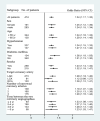Monocyte to high-density lipoprotein cholesterol ratio predicts restenosis of drug-eluting stents in patients with unstable angina pectoris
- PMID: 39632977
- PMCID: PMC11618658
- DOI: 10.1038/s41598-024-81818-9
Monocyte to high-density lipoprotein cholesterol ratio predicts restenosis of drug-eluting stents in patients with unstable angina pectoris
Abstract
Several studies have shown that the monocyte count to high-density lipoprotein cholesterol ratio (MHR) serves as a predictive marker for in-stent restenosis (ISR) of bare-metal stents (BMSs). However, the ability of the MHR to predict ISR in patients with drug-eluting stents (DESs) remains uncertain. This study aimed to investigate the predictive value of the MHR for ISR in patients with unstable angina pectoris who have undergone primary DES implantation. A total of 474 consecutive patients with unstable angina pectoris who underwent successful DES-based percutaneous coronary intervention (PCI) from 01-12-2014 to 01-12-2022 were enrolled in the study. Patients were divided into the ISR group and the non-ISR group on the basis of the follow-up results of coronary angiography. The demographic and clinical characteristics of the patients were documented. The MHR was calculated via the following formula: [Formula: see text]. Multivariate logistic regression models were developed to evaluate the predictive value of the MHR for DES-ISR. The baseline MHR was notably greater in the ISR group than in the non-ISR group (P < 0.001). After adjusting for confounding factors, the MHR emerged as an independent predictor of ISR (OR = 1.244; 95%CI 1.171-1.321). Receiver operating characteristic (ROC) curve analysis revealed that MHR for predicting ISR had an AUC of 0.752 (95% CI 0.708-0.796). For a MHR > 7.32, the sensitivity was estimated to be 59.8% (95% CI 47.2-66.5%) and the specificity was 81.2% (95% CI 71.2-86.4%). Including the MHR in the predictive model for ISR improved the area under the curve (0.698 vs. 0.782, P < 0.001), categorical net reclassification improvement (0.703; 95%CI 0.536-0.871), and integrated discrimination improvement (0.121; 95%CI 0.092-0.151). The MHR can be used to predict DES-ISR in patients with unstable angina pectoris, indicating that the MHR may serve as a valuable marker for risk stratification and prognosis in individuals undergoing DES implantation.
Keywords: Biomarker; Drug-eluting stent; In-stent restenosis; Monocyte-to-high-density lipoprotein cholesterol ratio; Percutaneous coronary intervention; Unstable angina pectoris.
© 2024. The Author(s).
Conflict of interest statement
Declarations. Competing interests: The authors declare no competing interests. Ethical approval and consent to participate: This study was submitted to and approved by the Ethics Commission of Chest Hospital, Tianjin University (IRB-SOP-016[F]-001-03), and strictly adhered to the principles of the Declaration of Helsinki. This was a retrospective study, so the content to be included was not applicable. Consent for publication: This study does not contain data from any individual person, so consent for publication is not applicable.
Figures




Similar articles
-
Analysis of the Correlation Between the Ratio of Monocytes to High-Density Lipoprotein Cholesterol and in-Stent Restenosis in Patients with Premature Coronary Heart Disease.Clin Appl Thromb Hemost. 2022 Jan-Dec;28:10760296221079334. doi: 10.1177/10760296221079334. Clin Appl Thromb Hemost. 2022. PMID: 35187964 Free PMC article.
-
A potential marker of bare metal stent restenosis: monocyte count - to- HDL cholesterol ratio.BMC Cardiovasc Disord. 2016 Oct 3;16(1):186. doi: 10.1186/s12872-016-0367-3. BMC Cardiovasc Disord. 2016. PMID: 27716070 Free PMC article.
-
Predictive Value of Monocyte to High-Density Lipoprotein Cholesterol Ratio for Target Lesion Revascularization in Patients With Drug-Eluting Stent Implantation.Int J Gen Med. 2025 Mar 7;18:1383-1391. doi: 10.2147/IJGM.S502386. eCollection 2025. Int J Gen Med. 2025. PMID: 40070681 Free PMC article.
-
Monocyte to HDL ratio in prediction of BMS restenosis in subjects with stable and unstable angina pectoris.Biomark Med. 2016 Aug;10(8):853-60. doi: 10.2217/bmm-2016-0071. Epub 2016 Jul 14. Biomark Med. 2016. PMID: 27415579
-
Neutrophil-to-lymphocyte ratio as a potential biomarker in predicting in-stent restenosis: A systematic review and meta-analysis.PLoS One. 2025 May 16;20(5):e0322461. doi: 10.1371/journal.pone.0322461. eCollection 2025. PLoS One. 2025. PMID: 40378151 Free PMC article.
Cited by
-
Elevated monocyte-to-high-density lipoprotein ratio is associated with increased risk of cognitive impairment and severe cerebral small vessel disease burden.Front Aging Neurosci. 2025 Jun 18;17:1588488. doi: 10.3389/fnagi.2025.1588488. eCollection 2025. Front Aging Neurosci. 2025. PMID: 40607185 Free PMC article.
-
The value of the monocyte to high-density lipoprotein cholesterol ratio in predicting the thrombosis burden and long-term prognosis of acute myocardial infarction patients: a retrospective cohort study.J Thorac Dis. 2025 May 30;17(5):3370-3379. doi: 10.21037/jtd-2025-517. Epub 2025 May 20. J Thorac Dis. 2025. PMID: 40529776 Free PMC article.
References
-
- Alfonso, F., Byrne, R. A., Rivero, F. & Kastrati, A. Current treatment of in-stent restenosis. J. Am. Coll. Cardiol.63, 2659–2673. 10.1016/j.jacc.2014.02.545 (2014). - PubMed
-
- Dangas, G. D. et al. In-stent restenosis in the drug-eluting stent era. J. Am. Coll. Cardiol.56, 1897–1907. 10.1016/j.jacc.2010.07.028 (2010). - PubMed
-
- Kanbay, M. et al. Monocyte count/HDL cholesterol ratio and cardiovascular events in patients with chronic kidney disease. Int. Urol. Nephrol.46, 1619–1625. 10.1007/s11255-014-0730-1 (2014). - PubMed
-
- Akboga, M. K. et al. Usefulness of monocyte to HDL-cholesterol ratio to predict high SYNTAX score in patients with stable coronary artery disease. Biomark. Med.10, 375–383. 10.2217/bmm-2015-0050 (2016). - PubMed
MeSH terms
Substances
LinkOut - more resources
Full Text Sources
Medical
Miscellaneous

